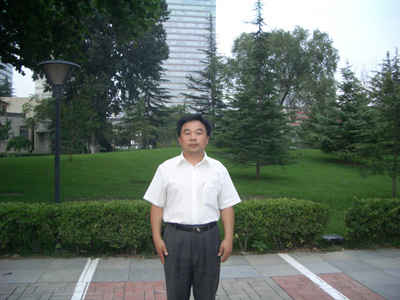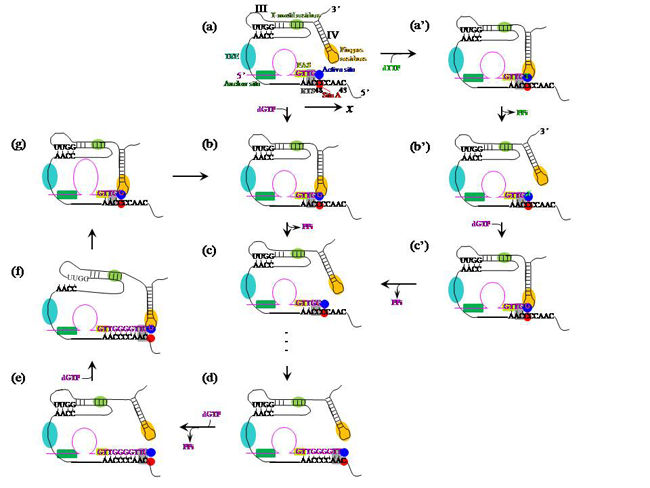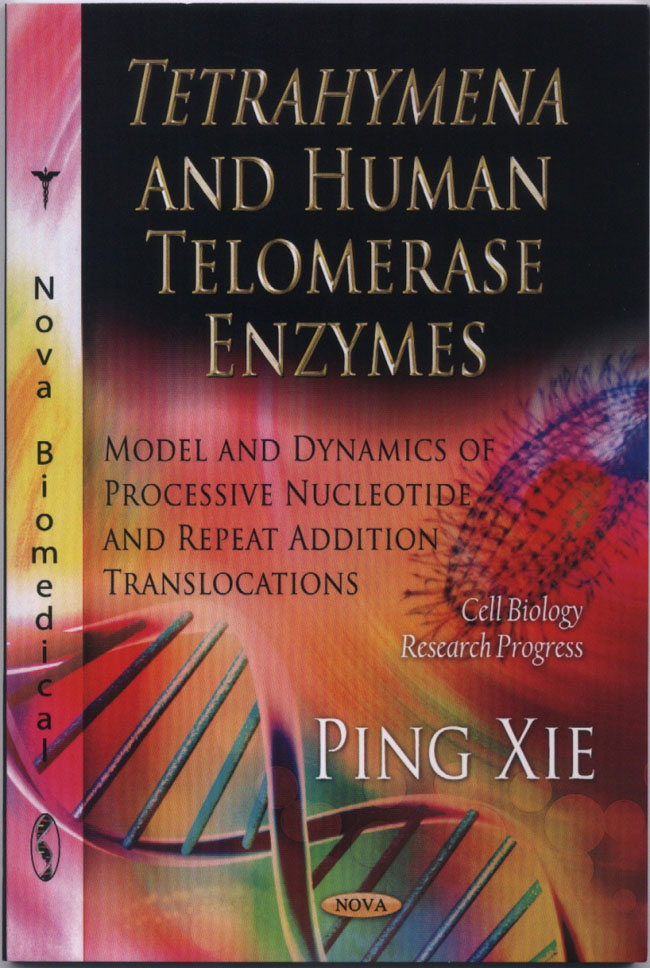
谢平,男,中国科学院物理研究所研究员,博士生导师。
教育及工作经历:
1984年,北京理工大学毕业获学士学位。
1990年,北京理工大学毕业获硕士学位。
1993年,中国科学院物理研究所毕业获博士学位。
现为中国科学院物理所研究员,博士生导师。
主讲课程:
资料更新中……
培养研究生情况:
资料更新中……
招生情况:
计划每年招收硕博连读生2名,博士生1名,博士后1名。
欢迎物理、化学、生物、专业的考生。
研究方向:
生物物理,侧重于生物分子马达的工作机理。
承担科研项目情况:
理论研究各种生物马达蛋白(例如:kinesin,myosin,dynein,Fo-F1ATPase等)和核酸酶(例如:DNAhelicase,DNApolymerase,RNApolymerase,viralreversetranscriptase,telomerase,ribosome,topoisomerase等)的运动和工作机理。
科研成果:
1. 生物体内绝大多数形式的运动,从细胞内部的物质运输,遗传物质(DNA)的复制,蛋白质的合成,细胞的分裂,到各种组织、器官乃至整个生物体的运动,归根到底都是在微观尺度上由具有马达功能的蛋白质大分子做功推动的结果。这些具有马达功能的蛋白质大分子,被称为分子马达。分子马达可以将化学能转化为机械能。到目前为止尽管人们对许多分子马达的生物功能已很清楚了解,但对任何一种分子马达的化学机械能转化的分子机制都没有完全理解。
2. 通过对已发表的实验数据进行分析,对端粒酶如何延长端粒提出了一个完善的解释,建立了端粒酶工作的微观模型,解释了端粒酶是如何能够利用自身很短的RNA模板实现端粒(DNA重复序列)延长,并对端粒酶的动力学特性给出了理论上的解析描述。
3. 受美国Nova科学出版社主编邀请,谢平撰写了一本专著。在专著中,谢平以四膜虫端粒酶和人的端粒酶为例,详细论述了自己所建立的端粒酶工作的分子机理的模型,利用所建模型对端粒酶工作的动力学特性进行了详细的理论分析和计算,并与已发表实验数据实验作了详细的比较,特别成功地解释了各种似乎矛盾的实验结果。这本专著为人们彻底了解端粒酶工作的分子机理迈出了重要的一步,将对人们如何利用端粒酶延缓人的衰老、进行衰老相关疾病和肿瘤的治疗等提供非常重要的指导意义。
 出版专著:
出版专著:
1. Ping Xie, Tetrahymena and Human Telomerase Enzymes: Model and dynamics of processive nucleotide and repeat addition translocations (New York : Nova Science, 2012).
代表性英文论文:
1. Ping Xie (2015) Dwell-time distribution, long pausing and arrest of single-ribosome translation through the mRNA duplex. Int. J. Mol. Sci. 16, 23723-23744.
2. Ping Xie (2015) Ribosome utilizes the minimum free energy changes to achieve the highest decoding rate and fidelity. Phys. Rev. E 92, 022716.
3. Ping Xie (2015) A unified model of nucleic acid unwinding by the ribosome and the hexameric and monomeric DNA helicases. J. Theor. Biol. 380, 359–366.
4. Ping Xie (2015) Model of ribosomal translocation coupled with intra- and inter-subunit rotations. Biochem. Biophys. Rep. 2, 87–93.
5. Ping Xie (2014) Origin of multiple intersubunit rotations before EF-G-catalyzed ribosomal translocation through the mRNA with a downstream secondary structure. BMC Biophys. 7:12.
6. Ping Xie (2014) Biphasic character of ribosomal translocation and non-Michaelis-Menten kinetics of translation. Phys. Rev. E 90: 062703
7. Ping Xie (2014) Dynamics of tRNA translocation, mRNA translocation and tRNA dissociation during ribosome translation through mRNA secondary structures. Eur. Biophys. J. 43:229–240.
8. Ping Xie (2014) Model of EF4-induced ribosomal state transitions and mRNA translocation. Phys. Biol. 11: 046007.
9. Ping Xie (2014) An explanation of biphasic characters of mRNA translocationin the ribosome. BioSystems 118, 1–7.
10. Ping Xie (2014) Dynamics of +1 ribosomal frameshifting. Mathematical Biosciences 249, 44–51.
11. Ping Xie (2013) A dynamical model of programmed -1 ribosomal frameshifting, J. Theor. Biol. 336:119–131.
12. Ping Xie (2013) Model of ribosome translation and mRNA unwinding. Eur. Biophys. J. 42:347–354.
13. Ping Xie (2013) Translocation dynamics of tRNA–mRNA in the ribosome, Biophys. Chem., 180-181, 22–28.
14. Ping Xie (2013) Dynamics of forward and backward translocation of mRNA in the ribosome, PLoS one 8:e70789.
15. Ping Xie (2013) Dynamics of tRNA occupancy and dissociation during translation by the ribosome. J. Theor. Biol. 316:49–60.
16. Ping Xie (2013) Dynamics of DNA polymerase I (Klenow fragment) under external force. J. Mol. Model. 19, 1379–1389.
17. Ping Xie (2012) A dynamic model for processive transcription elongation and backtracking long pauses by multi-subunit RNA polymerases. Proteins 80:2020–2034.
18. Duan ZW, Xie P*, Li W, Wang PY, Are coiled-coils of dimeric kinesins unwound during their walking on microtubule? PLos One 7, e36071 (2012).
19. Ping Xie (2012) Modeling translocation dynamics of strand displacement DNA synthesis by DNA polymerase I. J. Mol. Model. 18, 1951–1960. (2012).
20. Xie P, A nucleotide binding rectification Brownian ratchet model for translocation of Y-family DNA polymerases. Theor. Biol. Med. Mod. 8:22 (2011).
21. Xie P, A model for the dynamics of mammalian family X DNA polymerases. J. Theor. Biol. 277, 111–122 (2011).
22. Xie P, Sayers J.R., A model for transition of 5’-nuclease domain of DNA polymerase I from inert to active modes. Plos One 6, e16213 (2011).
23. Xie P, A modified model for translocation events of processive nucleotide and repeat additions by the recombinant telomerase. Biophys. Chem. 153, 83–96 (2010).
24. Xie P, Mechanism of processive movement of monomeric and dimeric kinesin molecules. Int. J. Biol. Sci. 6, 665–674 (2010) (Review Article)
25. Xie P, A model for processive movement of single-headed myosin-IX. Biophys. Chem. 151, 71–80 (2010)
26. Xie P, Dynamics of strand passage catalyzed by topoisomerase II. Eur. Biophys. J. 39, 1251–1259 (2010)
27. Xie P, Dynamics of DNA polymerases. Chapter 7 (pp. 228-262), in Bacterial DNA, DNA polymerase and DNA helicases, Edited by W.D. Knudsen and S.S. Bruns (New York : Nova Science, 2010) (invited article)
28. Xie P, Modeling DNA translocation and unwinding by helicase RecG. Chapter 9 (pp. 283-298), in Bacterial DNA, DNA polymerase and DNA helicases, Edited by W.D. Knudsen and S.S. Bruns (New York : Nova Science, 2010) (invited article)
29. Ping Xie (2010) Mechanism of processive movement of monomeric and dimeric kinesin molecules. Int. J. Biol. Sci. 6: 665–674 (Review article).
30. Xie P, A polymerase-site-jumping model for strand transfer during DNA synthesis by reverse transcriptase. Virus Research 144, 65–73 (2009)
31. Xie P, A possible mechanism for the dynamics of transition between polymerase and exonuclease sites in a high-fidelity DNA polymerase. J. Theor. Biol. 259, 434–439 (2009)
32. Xie P, On chemomechanical coupling of the F1-ATPase molecular motor. Biochim. Biophys. Acta – Bioenergetics 1787, 955–962 (2009)
33. Xie P, Dynamics of backtracking long pauses of RNA polymerase. Biochim. Biophys. Acta – Gene Regulatory mechanisms 1789, 212–219 (2009)
34. Xie P, Processive hand-over-hand motion of homodimeric nanomotors induced by the interaction between two monomeric components and thermal noise. Phys. Rev. E 79, 011920 (2009)
35. Xie P, Dynamics of DNA polymerases. Chapter 7 (pp. 228-262), in Bacterial DNA, DNA polymerase and DNA helicases, Edited by W.D. Knudsen and S.S. Bruns (New York : Nova Science, 2010).
36. Xie P, A possible mechanism of processive nucleotide and repeat additions by the telomerase. BioSystems 97, 168–178 (2009)
38. XieP,Steppingbehavioroftwo-headedkinesinmotors.Biochim.Biophys.Acta1777,1195–1202(2008).
39. Xie P, Model for RuvAB-mediated branch migration of Holliday junctions. J. Theor. Biol. 249, 566–573 (2007)
40. Xie P, On translocation mechanism of ring-shaped helicase along single-stranded DNA. Biochim. Biophys. Acta – Proteins and Proteomics 1774, 737–748 (2007)
41. Xie P, Model for forward polymerization and switching transition between polymerase and exonuclease sites by DNA polymerase molecular motors. Arch. Biochem. Biophys. 457, 73–84 (2007)
42. Xie P, Dou SX, Wang PY, Processivity of single-headed kinesin motor. Biochim. Biophys. Acta – Bioenergetics 1767, 1418–1427 (2007)
43. Xie P, Dou SX, Wang PY, Limping of homodimeric kinesin motors. J. Mol. Biol. 266, 976–985 (2007)
44. Xie P, Model for helicase translocating along single-stranded DNA and unwinding double-stranded DNA. Biochim. Biophys. Acta – Proteins and Proteomics 457, 1719–1729 (2006).
45. Zhang XD, Dou SX, Xie P, Hu JS, Wang PY, Xi XG, E. coli RecQ is a rapid, efficient and monomeric helicase. J. Biol. Chem., 281, 12655–12663 (2006)
46. Xie P, Dou SX, Wang PY, Model for unidirectional movement of axonemal and cytoplasmic dynein molecules. Acta Bioch. Biophys. Sin., 38, 711–724 (2006)
47. Qian J, Xie P*, Dou SX, Wang PY, A model for biased diffusion of collagenase along collagen fibrils. J. Theor. Biol. 243, 322–327 (2006)
48. Xie P*, Dou SX, Wang PY, Mechanochemical couplings of kinesin motors. Biophys. Chem., 123, 58–76 (2006)
49. Xie P*, Dou SX, Wang PY, A hand-over-hand diffusing model for processive movement of myosin-VI. Biophys. Chem., 122, 90–100 (2006)
50. Xie P*, Dou SX, Wang PY, Model for kinetics of myosin-V molecular motors. Biophys. Chem., 120, 225–236 (2006)
51. Xie P*, Dou SX, Wang PY, Model for kinetics of wild-type and mutant kinesins. BioSystems, 84, 24–38 (2006).
52. Xie P, Zhang ZQ, Zhang XD, Gap solitons and soliton trains in finite-sized two-dimensional periodic and quasiperiodic photonic crystals. PHYSICAL REVIEW E 67 (2): Art. No. 026607 Part 2 FEB 2003.
53. Xie P, Zhang ZQ, Multifrequency gap solitons in nonlinear photonic crystals. PHYSICAL REVIEW LETTERS 91 (21): Art. No. 213904 NOV 21 2003.
54. Xie P, Zhang ZQ, Dynamical control of light propagation in nonlinear photonic crystals by applied electric fields. JOURNAL OF APPLIED PHYSICS 95 (4): 1630-1633 FEB 15 2004.
55. Xie P, Zhang ZQ, Excitation of gap solitons, soliton trains, and soliton sets in finite-sized two-dimensional photonic crystals. PHYSICAL REVIEW E 69 (3): Art. No. 036601 Part 2 MAR 2004.
56. Xie P, Zhang ZQ, Optical phase conjugation in third-order nonlinear photonic crystals. PHYSICAL REVIEW A 69 (5): Art. No. 053806 MAY 2004.
57. Xie P, Zhang ZQ, Large enhancement of third-harmonic generation induced by coupled gap solitons in chi((3)) nonlinear photonic crystals. PHYSICAL REVIEW E 71 (2): Art. No. 026610 Part 2 FEB 2005.
58. Yang H, Xie P, Chan SK, et al., Efficient second harmonic generation from large band gap II-VI semiconductor photonic crystal. APPLIED PHYSICS LETTERS 87 (13): Art. No. 131106 SEP 26 2005.
59. Xie P, Zhang ZQ, Nondegenerate two-beam coupling in Kerr nonlinear photonic crystals. PHYSICAL REVIEW E 72 (3): Art. No. 036607 Part 2 SEP 2005.
60. Yang H, Xie P, Chan SK, Lu WX, Zhang ZQ, Sou IK, Wong GKL, Wong KS, Simultaneous enhancement of the second and third harmonic generations in one-dimensional semiconductor photonic crystal. IEEE JOURNAL OF QUANTUM ELECTRONICS 42 (3-4): 447-452 MAR-APR 2006.
61. Lu WX, Xie P, Zhang ZQ, et al., Simultaneous perfect phase matching for second and third harmonic generations in ZnS/YF3 photonic crystal for visible emissions. OPTICS EXPRESS 14 (25): 12353-12358 DEC 11 2006.
62. Xie P, Zhang ZQ, High-efficient generation of both forward and backward optical phase conjugation in one-dimensional nonlinear photonic crystals. JOURNAL OF APPLIED PHYSICS 99 (8): Art. No. 083106 APR 15 2006.
63. Xie P, Dai JH, Wang PY, et al., Self-pumped phase conjugation in photorefractive crystals: Reflectivity and spatial fidelity. PHYSICAL REVIEW A 55 (4): 3092-3100 APR 1997.
64. Xie P, Dai JH, Wang PY, et al., Spatial fidelity of externally pumped phase conjugation in photorefractive crystals. JOURNAL OF THE OPTICAL SOCIETY OF AMERICA B-OPTICAL PHYSICS 14 (4): 852-859 APR 1997.
65. Xie P, Dai JH, Wang PY, et al., Temporal behavior and instabilities of the self-pumped phase conjugation in photorefractive crystals. PHYSICAL REVIEW A 56 (1): 936-943 JUL 1997.
66. Xie P, Wang PY, Dai JH, et al., Backward beam fanning in photorefractive crystals. JOURNAL OF THE OPTICAL SOCIETY OF AMERICA B-OPTICAL PHYSICS 15 (5): 1521-1527 MAY 1998.
67. Xie P, Wang PY, Dai JH, et al., Effect of random volume scattering on image amplification and beam fanning in photorefractive materials. JOURNAL OF THE OPTICAL SOCIETY OF AMERICA B-OPTICAL PHYSICS 15 (7): 1889-1894 JUL 1998.
68. Xie P, Wang PY, Dai JH, et al., Frequency shifts and dynamic instabilities in photorefractive self-pumped and mutually pumped phase conjugation. JOURNAL OF THE OPTICAL SOCIETY OF AMERICA B-OPTICAL PHYSICS 16 (3): 420-427 MAR 1999.
69. Xie P, Wang PY, Dai JH, Electric-field-induced frequency shift and temporal instability in a self-pumped phase conjugator using BaTiO3. OPTICS COMMUNICATIONS 177 (1-6): 413-416 APR 15 2000.
70. Xie P, Wang PY, Dai JH, Stabilization of unstable steady states in photorefractive phase conjugators. JOURNAL OF THE OPTICAL SOCIETY OF AMERICA B-OPTICAL PHYSICS 17 (6): 1004-1007 JUN 2000.
71. Xie P, Wang PY, Dai JH, Stabilization of unstable steady states in photorefractive phase conjugators. JOURNAL OF THE OPTICAL SOCIETY OF AMERICA B-OPTICAL PHYSICS 17 (6): 1004-1007 JUN 2000.
72. Xie P, Wang PY, Dai JH, Origin of frequency shift and temporal instability in photorefractive self-pumped phase conjugators. JOURNAL OF THE OPTICAL SOCIETY OF AMERICA B-OPTICAL PHYSICS 17 (7): 1182-1187 JUL 2000.
73. Taj IA, Xie P, Mishima T, Anomalous temporal behavior of photorefractive wave mixing owing to the existence of both positive and negative charge carriers. JOURNAL OF THE OPTICAL SOCIETY OF AMERICA B-OPTICAL PHYSICS 17 (10): 1740-1748 OCT 2000.
74. Taj IA, Xie P, Mishima T, Fast switching of photorefractive output by applied electric field OPTICS COMMUNICATIONS 187 (1-3): 7-15 JAN 1 2001.
75. Xie P, Taj IA, Mishima T, Suppressing fluctuation of photorefractive output. JOURNAL OF THE OPTICAL SOCIETY OF AMERICA B-OPTICAL PHYSICS 18 (4): 492-496 APR 2001.
76. Xie P, Taj IA, Mishima T, Origin of temporal fluctuation in the photorefractive effect. JOURNAL OF THE OPTICAL SOCIETY OF AMERICA B-OPTICAL PHYSICS 18 (4): 479-484 APR 2001.
77. Xie P, Taj IA, Mishima T, Reducing temporal fluctuation of signal intensity in optical wave mixing. IEEE JOURNAL OF QUANTUM ELECTRONICS 37 (5): 664-671 MAY 2001.
78. Taj IA, Xie P, Mishima T, Effect of the relative phase of grating components on the temporal behavior of photorefractive four-wave mixing. JOURNAL OF THE OPTICAL SOCIETY OF AMERICA B-OPTICAL PHYSICS 18 (10): 1490-1496 OCT 2001.
79. Xie P, Mishima T, Temporal fluctuation in photorefractive wave mixing. IEEE JOURNAL OF QUANTUM ELECTRONICS 37 (11): 1388-1395 NOV 2001.
80. Xie P, Mishima T, Reduction of the temporal fluctuation of the signal intensity in optical wave mixing with a reflection grating. APPLIED OPTICS 41 (6): 1113-1119 FEB 20 2002.
81. Mishima T, Xie P, Koyanagi K, Taj IA, Demonstration of fast switching of photorefractive four-wave mixing via Pockels effect. OPTICS COMMUNICATIONS 225 (1-3): 211-214 SEP 15 2003.
82. Taj IA, Xie P, Koyanagi K, et al., Photorefractive four-wave mixing switches utilizing pockels effect - Longitudinal and lateral switches. OPTICAL REVIEW 11 (5): 332-336 SEP-OCT 2004.
83. Xie P, Mishima T, Fast switching of light propagation in a photorefractive crystal via Pockels effect. OPTICS COMMUNICATIONS 246 (1-3): 29-34 FEB 1 2005
端粒可以看着为“生命时钟”。在细胞中,细胞每分裂一次,端粒就缩短一次。当端粒不能再缩短时,细胞就无法继续分裂而衰老和死亡。相反,如果端粒的长度能得以保持不变,细胞将延缓衰老。端粒酶是能够实现端粒延长的酶或分子马达。在细胞中,由于端粒酶的存在,端粒的长度能够维持不变。在癌细胞中端粒酶大量表达,因而癌细胞被认为是具有永久生命力的。然而,在我们的体细胞中,端粒酶含量极低,因而端粒不断地缩短,导致体细胞的衰老或癌变。由于端粒和端粒酶在衰老、衰老相关疾病(如冠心病、高血压、痴呆、肥胖等)和癌症发生发展过程中的重要作用,将2009年诺贝尔生理学或医学奖授予端粒和端粒酶研究的开创者。
尽管端粒酶的生物功能已被确定, 但其如何延长端粒的分子机理仍不清楚。鉴于此,自1985年端粒酶首次发现以来,为了解其工作机理人们对其工作的动力学特性进行了大量的实验研究,并积累了大量的实验数据。近几年来,中科院物理所/北京凝聚态物理国家实验室(筹)软物质实验室sm1组谢平研究员通过在大量已发表实验数据分析的基础上,对端粒酶如何延长端粒提出了一个完善的解释,建立了端粒酶工作的微观模型,解释了端粒酶是如何能够利用自身很短的RNA模板实现端粒(DNA重复序列)延长的,对端粒酶的动力学特性(如:端粒酶与端粒一次结合能够延长端粒的长度等)给出了理论上解析描述,定量解释了已发表的各种不同的实验结果,并预言了新的动力学特性。相关论文发表后[BioSystems 97, 168–178 (2009);Biophys. Chem. 153, 83–96 (2010)]即受到重视,因此,被美国Nova科学出版社主编Nadya Gotsiridze-Columbus博士邀请撰写了专著一本(Tetrahymena and Human Telomerase Enzymes: Model and dynamics of processive nucleotide and repeat addition translocations, Nova Science Publishers, Inc. New York, 2012)。在专著中,以四膜虫端粒酶和人的端粒酶为例,详细论述了谢平研究员自己所建立的端粒酶工作的分子机理的模型,利用所建模型对端粒酶工作的动力学特性进行了详细的理论分析和计算,并与已发表实验数据实验作了详细的比较,特别成功地解释了各种似乎矛盾的实验结果。在专著中也对以后的理论和实验工作做了展望。
本专著为人们彻底了解端粒酶工作的分子机理迈出了重要的一步。而通过对端粒酶分子工作机理的了解,将对如何利用端粒酶延缓人的衰老、进行衰老相关疾病和肿瘤的治疗等提供非常重要的指导意义。
本项研究工作得到国家自然科学基金项目的资助。

图:四膜虫端粒酶工作机理模型示意图

来源:中国科学院物理研究所 2012-08-22
中国科技创新人物云平台暨“互联网+”科技创新人物开放共享平台(简称:中国科技创新人物云平台)免责声明:
1、中国科技创新人物云平台是:“互联网+科技创新人物”的大型云平台,平台主要发挥互联网在生产要素配置中的优化和集成作用,将互联网与科技创新人物的创新成果深度融合于经济社会各领域之中,提升实体经济的创新力和生产力,形成更广泛的以互联网为基础设施和实现工具的经济发展新形态,实现融合创新,为大众创业,万众创新提供智力支持,为产业智能化提供支撑,加快形成经济发展新动能,促进国民经济提质增效升级。
2、中国科技创新人物云平台暨“互联网+”科技创新人物开放共享平台内容来源于互联网,信息都是采用计算机手段与相关数据库信息自动匹配提取数据生成,并不意味着赞同其观点或证实其内容的真实性,如果发现信息存在错误或者偏差,欢迎随时与我们联系,以便进行更新完善。
3、如果您认为本词条还有待完善,请编辑词条。
4、如果发现中国科技创新人物云平台提供的内容有误或转载稿涉及版权等问题,请及时向本站反馈,网站编辑部邮箱:kjcxac@126.com。
5、中国科技创新人物云平台建设中尽最大努力保证数据的真实可靠,但由于一些信息难于确认不可避免产生错误。因此,平台信息仅供参考,对于使用平台信息而引起的任何争议,平台概不承担任何责任。

















